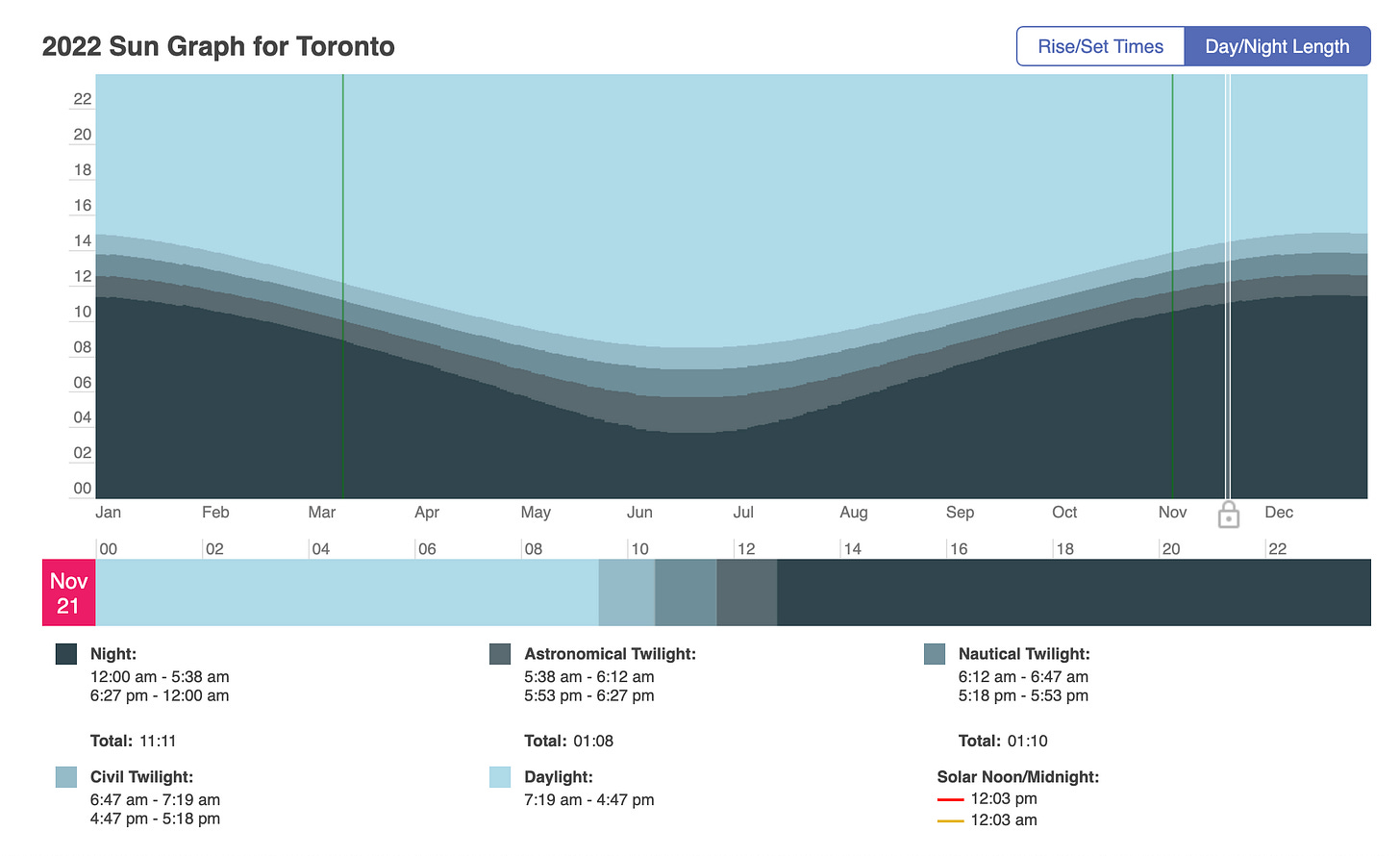Marking time: It won't get too much darker
We're still one month away from the solstice, but the worst is already over.
Tomorrow is one month away from the winter solstice — the darkest day of the year.
If you’ve followed me over the years, you might know that I’m a nerd about time zones, daylight saving time, and other assorted time stuff. I actually once did a lot of research for a book that I never wrote on the topic.
The numbers and visuals here are all for Toronto, Ont. because that’s where I live. But if you live elsewhere, you can look up your locally relevant data at the very best website on the internet — www.timeanddate.com.
Numbers:
On November 21, the sun will rise at 7:19 a.m. and set at 4:47 p.m. giving us 9 hours, 27 minutes and 52 seconds of daylight.
On December 21, the sun will rise at 7:47 a.m. and set at 4:43 p.m. giving you 8 hours 55 minutes and 44 seconds of daylight.
So, on the darkest day of the year we’ll have about 32 minutes less daylight.
Now, let’s look back one month. On October 21, the sun rose at 7:39 a.m. and set at 6:42 p.m. giving us 10 hours 45 minutes and 3 seconds of daylight.
So, in the past month the days have gotten shorter by about 1 hour and 16 minutes.
In the month before that, the time loss was even more dramatic. From September 21 to Oct. 21 the amount of daylight got shorter by about 1 hour and 27 minutes.
What’s going on here? Well, this handy visualization on Time and Date shows that sunrise and sunset move on a curve.
What that means is, in the spring and the fall there’s a period where the days get longer or shorter at a rapid pace. During the steepest part of the curve in the fall, the amount of daylight gets shorter by nearly three full minutes each day.
Right now, the amount of daylight is getting shorter by about 2 minutes. Once we get close to the winter solstice on December 21, the difference in daylight will only shift by a few seconds each day.
A word on daylight saving time, specifically
This is not a post about daylight saving time, a topic which is the source of much gnashing of teeth and rending of garments. I have an opinion on the topic, which I will perhaps write in another post sometime.
My point for today is only that the fixation on clock-switching masks the much, much larger reality of the rhythms of the seasons and daylight.
The east-west longitude of where you live dictates when the sun will come up relative to the clock, and north-south latitude dictates how dramatically the days will lengthen and shorten throughout the year.
Montreal and Toronto are in the same time zone, but sunrise is 18 minutes earlier today in Montreal.
That might not sound like a lot, but it’s the difference between beams of light streaming in through the window when your alarm goes off at 7am, versus the twilight glow of the sun below the horizon when you wake up.
Because it’s jarring, especially in the spring, people tend to notice daylight saving time, and they tend to have strong feelings. But the reality is that your experience of sunrise and sunset is wildly more complex than that.
In conclusion:
The length of the days, and the time of sunrise and sunset affect us, even though most of us live our lives ruled by a relentless and indifferent clock.
I spend lots of time on Time and Date because I love to think about the clocks and the rhythms of the astronomical seasons. I think about how the plants react, and how my animal brain is processing it.
Each week of the year has a subtly different flavour.
The angle of the light in the winter is different, as the sun tracks farther south in the sky.
The length of the day, and critically the rate of change as the days get shorter or longer, dramatically affects our experience in subconscious ways.
Right now, we are just coming to the end of the phase when the days get shorter at a relentless pace. For most of us, it is now dark when we wake up, and it is dark when we get to the end of the workday.
The good news is that it won’t get much darker. We are now a month away from the darkest day of the year and that day will only be about half an hour darker than today.
Hunker down. Snuggle with somebody. Read a book under the warm light of a lamp.
It’s going to be like this for another few months as the snow piles up, but by February, even before there’s any warmth in the air, the light will start to come back, as we begin to climb the other side of the curve.


I live close to the west edge of my time zone so I get this.